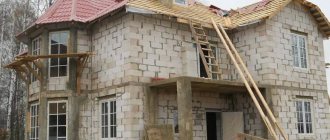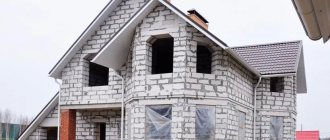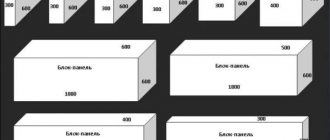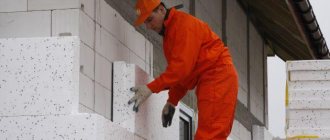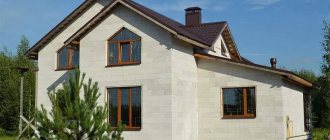The construction of foam blocks is erected quickly. The issue of exterior decoration of a house made of foam blocks, which of all varieties is best, should be resolved long before the start of finishing work. The article describes the features of foam block walls, which impose restrictions on the choice of finishing cladding. You will learn what can and cannot be used to finish foam concrete, and also get acquainted with the advantages and disadvantages of popular options.
Finishing is just around the corner Source stavlib.org.ru
Features of foam concrete and finishing requirements
Foam concrete is part of the family of lightweight cellular concrete and has a characteristic porous structure. In modern country house construction, foam concrete is one of the most common materials. The reason for its popularity lies in its numerous advantages due to its internal structure.
Walls made of foam concrete blocks are distinguished not only by quick construction, but also by low thermal conductivity, which allows you to save on insulation. An important feature of foam concrete that affects the specifics of external and internal finishing work is its fairly noticeable vapor permeability. External finishing should be selected in such a way that natural air exchange between the home and the street is not hampered, and the microclimate always remains comfortable. Facing materials must perform several functions:
- Serve to protect the wall structure from precipitation.
Proper cladding combines practical and aesthetic benefits Source kromvel.kz
- Act as an additional insulating layer .
- Create an aesthetic appearance , the “face” of the house.
- Maintain moisture and heat exchange , normalizing the housing microclimate.
- Prevent the appearance of condensation and acid damage on the surface of the walls.
It is believed that a building made of foam blocks can be left without finishing if the laying of the blocks and the processing of the seams is done perfectly evenly. Such buildings are found in a number of European countries and completely satisfy the owners with their performance characteristics; the only thing that can suffer is aesthetic perception. In the external pores (on the surface of the walls), dirt accumulates over time, rainwater gets there, after which acid reactions are started. The walls begin to darken, and this process proceeds unevenly; Sometimes destruction of the outer layer of foam concrete is observed. Therefore, most experts still recommend cladding the house; The question of how to decorate the exterior of a house made of foam blocks has several answers.
Hygroscopicity is the main quality of the material Source besplatka.ua
See also: Catalog of house projects made from foam concrete blocks
How to make external thermal insulation of foam concrete buildings?
The technology for laying insulation has its own characteristics. Before starting work, the master must familiarize himself with the manufacturer’s instructions for laying insulation and preparing adhesive and other mixtures that will be required in the process of performing thermal protection.
This is necessary so that the main and additional materials are consistent with each other without coming into conflict, thereby not destroying the surface.
The main stages of external thermal insulation of walls using Penoplex as an example:
Carefully prepare the surface, clean it from dust and dirt and excess deposits of cement mortar.- Treat the walls with a primer to ensure adhesion of the adhesive solution to the outside of the walls.
- Attach the starting metal profile to the bottom of the wall to secure the layers of insulation and protect it from rodents.
- According to the manufacturer's instructions, prepare glue for fixing heat-insulating boards, mix the solution in a clean container, and mix with a drill attachment.
- Using a spatula, apply the adhesive solution around the perimeter of the slab and in the center.
- Laying occurs from below, the seams are shifted in each subsequent row so that the sheets are arranged in a checkerboard pattern.
- According to the time specified by the manufacturer, they wait for the glue on the slabs to dry and begin to additionally secure the Penoplex with disc dowels, 5 pieces per sheet.
- A fiberglass mesh is glued onto the fixed insulation, first the corners are glued, and then the walls.
- The mesh is fixed with a layer of glue, and after drying, the walls of the house are plastered and painted.
Qualities required for finishing materials
All facade materials, regardless of the surface they are intended for finishing, must have mechanical strength, resistance to ultraviolet radiation and decorative value. In addition, facing materials for foam block walls must meet the following conditions:
- Vapor permeability . The material should not interfere with air exchange, otherwise the air in the rooms will begin to stagnate, and moisture will begin to accumulate in the load-bearing walls.
- Waterproof . The finishing must reliably protect the wall structure from rain and snow.
- Frost resistance . The cladding structure must be designed to withstand a sufficient number of freezing/thawing cycles without changing the appearance.
For long-term operation of a house made of foam blocks, additional measures will be extremely useful: a properly designed roof and protective elements: canopies, gutters, window drains, flashings for the foundation base. At the same time, all these wonderful devices will be of little use if the finishing material is chosen incorrectly.
In most regions, frost resistance of cladding is important Source remcraft.ru
Improper finishing of a house made of foam blocks from the outside will begin to retain water vapor, which, when condensed, will lead to the destruction of the foam blocks. The options that can destroy foam concrete include the following materials:
- Ceramic and concrete tiles.
- Facade paint that forms a vapor barrier (with low vapor permeability).
- Cement plaster.
- Plates made of foamed polymer (PVC).
See also: Catalog of companies that specialize in completing unfinished houses
Exterior materials
There are three directions for exterior finishing of a house made of foam blocks; the options look like this:
- Arrangement of a ventilated facade . Vinyl siding, corrugated sheeting, hanging cassettes or fiber cement boards are mounted on the sheathing.
- Facing with decorative stone , some types of tiles or brick.
- Plastering , possibly followed by painting.
Scheme of a ventilated facade Source kdomu.by
Basic Rules
When selecting materials for cladding a house from the street, be sure to remember that in order to maintain normal humidity in the rooms, the vapor permeability of the materials must decrease from inside the room to the outside. That is, the exterior finishing should conduct steam better than the wall material. Then the increased humidity, which is typical for our homes, will be removed through the walls naturally (explanations in the photo).
When deciding what is best to sheathe the outside of the house, do not forget to take into account the vapor permeability of the materials
If this principle is violated, moisture will accumulate at the interface of materials with different vapor permeability. It condenses, creating conditions for rotting and the development of fungi and mold. In winter it freezes, destroying the wall material and/or finishing. Sooner or later such a system will have to be dismantled and rebuilt.
The trouble is that only wood meets this requirement. Most other materials for exterior decoration of a house have low vapor permeability. The problem is solved in two ways:
- A ventilated facade is being installed. A ventilated gap with a width of 60 mm to 150 mm is left between the wall or insulation layer (with high vapor permeability) and the finishing. Ventilation holes are left at the bottom of the cladding at the rate of 75 cm2 for every 20 m2 of wall, including windows and doors. Air will enter through them. There are exit holes at the top. With this device, moisture will be removed from the wall material or insulation, and the outer cladding will protect from precipitation and perform a decorative function.
- The finishing material is attached directly to the wall. But from the inside the wall must be protected by a layer of vapor barrier. In this case, the penetration of vapors into the wall material is prevented and it remains dry. Excess moisture is removed by the ventilation system.
Today the second option is becoming increasingly popular. Very effective thermal insulation materials have appeared that can significantly reduce heating costs. But they have very low vapor permeability (expanded polystyrene and extruded polystyrene foam). When using them, only the second humidity control scheme is possible. When choosing what to cover your house with, consider these points.
Ventilated facades
Ventilated facades are a finishing method in which a gap is left between the wall and the cladding. The method is considered optimal for foam block construction, and therefore is widely used in practice; developers choose it due to the following factors:
- In the space between the facade and the cladding constant air exchange , the vapor permeability of load-bearing walls is not impaired, and condensation does not accumulate in masonry joints. All together has a positive effect on the microclimate in the house and extends the life of the building.
- The frame on which the facing material is mounted is made of wood, metal profile or plastic . Wood frames are the most common; The metal profile has a negative feature - condensation can form on it.
What to choose
- Cover the walls with insulation (for example, mineral wool) and line them with bricks in 1 row. There are also such recommendations. But it’s quite difficult to call this finishing method budget-friendly. Even without taking into account the cost of the brick, additional strengthening of the foundation will be required, and this is again an expense.
- Panels. The assortment is quite large. But if you take into account their cost, then the best option is PVC products (plastic siding). There are many advantages - quick installation (you can do it yourself, read how), light weight, practically no maintenance (easy to clean if necessary), and so on. In combination with foam concrete - one of the cheapest combinations.
Video description
About the nuances of installing siding in the following video:
Materials hung on a ventilated facade have the following features:
Facade cassettes
A cassette curtain façade can often be found on industrial or administrative buildings than on a country house. But nothing prevents you from using this option for your own home; By purchasing a cassette facade system made of aluminum, you receive a complete installation kit with detailed instructions. Lightweight and durable cassettes are used both for decoration and for insulation; The reason for its rare use in private construction is the high price.
See also: Catalog of companies that specialize in the reconstruction and rebuilding of houses
Corrugated sheet
When finishing the façade of a house made of foam blocks, there is a profiled steel sheet, a material produced by cold rolling. Thanks to its complex profile in the shape of a wave or trapezoid, it has increased rigidity. The service life of corrugated sheets is increased by the following coatings:
- Zinc . It has good anti-corrosion properties, increases the resistance of the corrugated sheet to moisture, but does not have any special decorative advantages (especially for a private home).
Finishing with corrugated sheets Source infokanal55.ru
- Polymer . Also has a protective function. In addition, corrugated sheeting with a polymer or paint coating is distinguished by a wide color palette, which allows you to diversify the appearance of the building.
The positive qualities that make it necessary to use corrugated sheets for a ventilated facade are uncomplicated installation, without additional finishing, fire resistance and tightness of the cladding, and easy maintenance throughout the entire service life. The downside is the drum effect - the material can amplify the sound during rain. Also, if the protective layer is damaged, corrosion can begin.
Video description
About finishing a house with fiber cement in the following video:
Vinyl siding
Plastic (vinyl) panels are a popular way of arranging a ventilated facade. Siding panels consist of two layers: the inner layer gives strength, keeping the geometry of the material unchanged; the outer, thinner layer provides protection from precipitation and ultraviolet radiation. The facing material is characterized by many advantages:
- Resistant to a wide range of influences , including temperature fluctuations and moderately acidic and alkaline environments. The original color and shape are maintained throughout the entire service life.
- Budgeting . Vinyl siding has an optimal price/quality ratio.
- Variety . On the construction market, you can choose a material to match any color palette. You can decorate your home in any style.
- Easy installation and maintenance.
The disadvantage of low-quality vinyl siding can be its cracking when exposed to low temperatures. In addition, violation of the installation technology can lead to tearing of the skin in strong winds.
Vinyl siding Source www.yugkrovlya.ru
Plaster and paint
These methods of finishing foam block facades are recommended in fairly warm regions where an additional insulating layer is not required. Plaster acts as a good protection for cellular concrete and an insurmountable barrier to atmospheric moisture. Usually the plaster is covered with a layer of special facade paint or decorative plaster. The technology for plastering foam concrete walls includes the following features:
- Temperature restrictions . For high-quality results, it is necessary to observe the temperature regime during operation. The technology involves sequential application of several layers, each subsequent one after the previous one has dried. This can only be achieved if the average daily ambient temperature does not fall below +5°C.
- Surface preparation . To avoid the appearance of dampness, the walls are first coated with a primer. A reinforcing mesh is attached to the top with façade dowels, increasing the strength of the plaster layer and preventing the appearance of cracks on the surface.
Decorative plaster on houses made of foam blocks
This option is quite labor-intensive, and not particularly durable or practical. To apply decorative plaster, the walls of the house must first be leveled using starting and finishing putty, then primed with a deep-penetrating protective primer. Before applying a layer of plaster, you should not forget about reinforcing mesh in areas of stress concentration (along the contour of window openings, as well as in the corners of the building).
The hinged ventilated facade consists of several functional layers
To plaster the prepared surface, special plaster mixtures with increased vapor permeability are used. They are designed to withstand temperature changes and environmental conditions. These mixtures contain special elements that give the walls an original texture. It is not difficult to find them on sale; they are produced by most manufacturers of dry building mixtures.
When working with plaster, you must strictly follow the general rules and instructions, observe the humidity and temperature conditions, and also prevent the mixture from freezing or drying out.
Video description
How to plaster walls made of foam blocks in the following video:
- Plastering . The material is applied in two stages: first, the reinforcing mesh is closed, then the surface is leveled.
- Decoration . After drying, finishing (decorative) plaster or painting is carried out.
Exterior finishing of a house made of foam blocks for plastering or painting involves choosing materials with the following properties:
- Plaster mixture . Standard sand-cement plaster mixture is not suitable for use on foam block walls that poorly absorb moisture. An acceptable option are mixtures with adhesive additives that increase the adhesion index (adhesion to the surface). Plaster mixtures intended for foam concrete have the necessary vapor-permeable and waterproofing parameters.
- Dye . The main condition is that the paint must be vapor-permeable; Silicone paints and primers are ideal for foam concrete. Using paint that is not suitable for lightweight concrete will stop air exchange and lead to the accumulation of moisture in the cladding structure.
Finishing the facade with plaster Source buduj.pp.ua
What to consider
Regardless of the chosen method of external design, care must be taken to ensure that the walls are effectively vapor permeable. This is what determines both the choice of materials and the production technology. In addition, the quality of waterproofing is also important, since foam concrete still partially absorbs liquids, although not as intensely as its close “relative” - gas silicate.
It makes no sense to dwell in detail on all technological operations for external cladding of surfaces, since this is the topic of another article. But what criteria should be used to choose wall and other materials, what design nuances should you pay attention to - this is worth understanding in detail.
Cladding with piece material
Brick, stone and tile are materials that are characterized by significant weight. Their use in cladding should be provided for at the design stage of the house. Wall structures made of foam concrete blocks weigh relatively little, and therefore the foundation of such a building is usually laid lightweight. If heavy finishing is used, the base should be wider and deeper. One of the popular cladding methods is brick; its use is possible due to its positive properties:
- Protection and insulation . Brickwork is a reliable way to protect foam concrete from any natural precipitation and temperature fluctuations.
- Increased service life . Brick cladding gives foam concrete walls additional strength, thereby extending the service life of the supporting structure.
- Aesthetics . Brick walls are a timeless classic of country house construction.
- Easy maintenance . If you choose brick as an exterior finish, you won’t have to waste time on additional care.
Video description
About facing the facade with stone in the following video:
The main limiting factor when choosing a brick finish is cost - the spectacular appearance of such a house will be quite expensive. A common drawback of low-quality brick is the appearance of efflorescence (salt stains), which significantly worsens the appearance.
Finishing foam concrete walls with stone is carried out only if there is a strong foundation. The house, lined with natural stone, has an unusually attractive appearance. There are many colors and textures of stone finishing, which is not only aesthetically pleasing, but also practical, since it will last as long as possible without much hassle. Poor-quality installation can briefly overshadow the choice of stone cladding - individual stones can lag behind the foam concrete, which, however, can be easily corrected.
Brick finishing Source svarnayasetka.by
To finish a facade made of foam blocks, you can use clinker, ceramic and porcelain tiles, for which you will need to perform the following preparatory work:
- Prime the wall surface with a waterproofing compound.
- If necessary , insulate the walls (the standard choice is mineral wool or fiberglass).
- Install a frame made of aluminum profiles and secure sheets of drywall to it. Foam concrete walls will be provided with effective ventilation.
- Cover the prepared surface using an adhesive solution.
The tiled facade will be a practical protection of foam blocks from moisture and temperature fluctuations. This finishing option is common due to its good price/quality ratio and aesthetic possibilities - imitation of ceramic brick or natural stone would be ideal. The main disadvantage of tiled cladding is the financial and time costs of preparing the walls.
Finishing with artificial stone Source uf.ru
